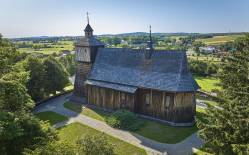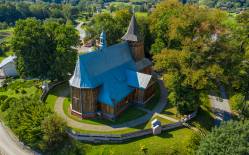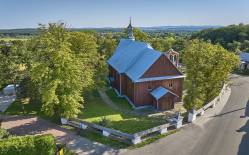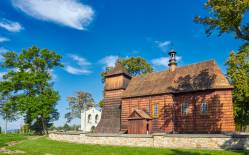The earliest record of a parish existing in Lubla dates from 1277. Church of St. Nicholas the Bishop was built in the mid-1400s by Mikołaj Grot, the abbot of the Cistercian Monastery in Koprzywnica. The tower, added in 1793, was destroyed during wartime operations in August of 1944, and then reconstructed, along with the fence, in 1995.
The church was remodelled a number of times, in 1778, 1838, 1862, 1922 and shortly after WWII. Subsequent conservation works were initiated in 2003, when the original form of the building was restored.
Inside we can see Baroque altars dating from 1709 and 1769. Particularly notable are the Gothic painting Misericordia Domini in the left-side altar, from the mid-1400s, two late Gothic paintings in the high altar, depicting Mary, the Mother of Jesus as the Queen of Angels and the patron of the church St. Nicholas, as well as representations of St. Anne with Mary and the Child, and St. Joachim in the right-side altar.
In the left-side altar there is a late Baroque frontal with representations of Jesus with a crown of thorns and the death of St. Stanislaus the Bishop. The rood beam features a Baroque cross from the 1600s and rococo angels with candlesticks.
Other interesting features include a rococo pulpit from 1778 and a confessional from the second half of the 1700s, as well as the most valuable sculpture here - a 18th century figure of the Immaculate Virgin Mary in a style of Italian Baroque. The wall paintings were renovated a number of times in the 1800s and 1900s. In place of the old pipe organs from the 1600s today we can see the new ones from 1962.
On the southern wall of the bell tower there is a head of Jesus, commemorating an unusual incident. In January 1945, when Lubla was under attack, a shell exploded and destroyed a cross but Christ’s head remained intact and got stuck in the wooden wall.
The bell tower next to the church holds a bell from the late 1400s.
Photo: Krystian Kłysewicz
Gallery

Recommended venues on the Trail



This website has been modernized with the financial support of the European Union under the Cross-Border Cooperation Programme Poland-Belarus-Ukraine 2014-2020. The responsibility for its content lies solely with the Podkarpackie Regional Tourism Board and cannot, in any case, be treated as a reflection of the position of the European Union, the Managing Authority, or the Joint Technical Secretariat of the Cross-Border Cooperation Programme Poland-Belarus-Ukraine 2014-2020.













